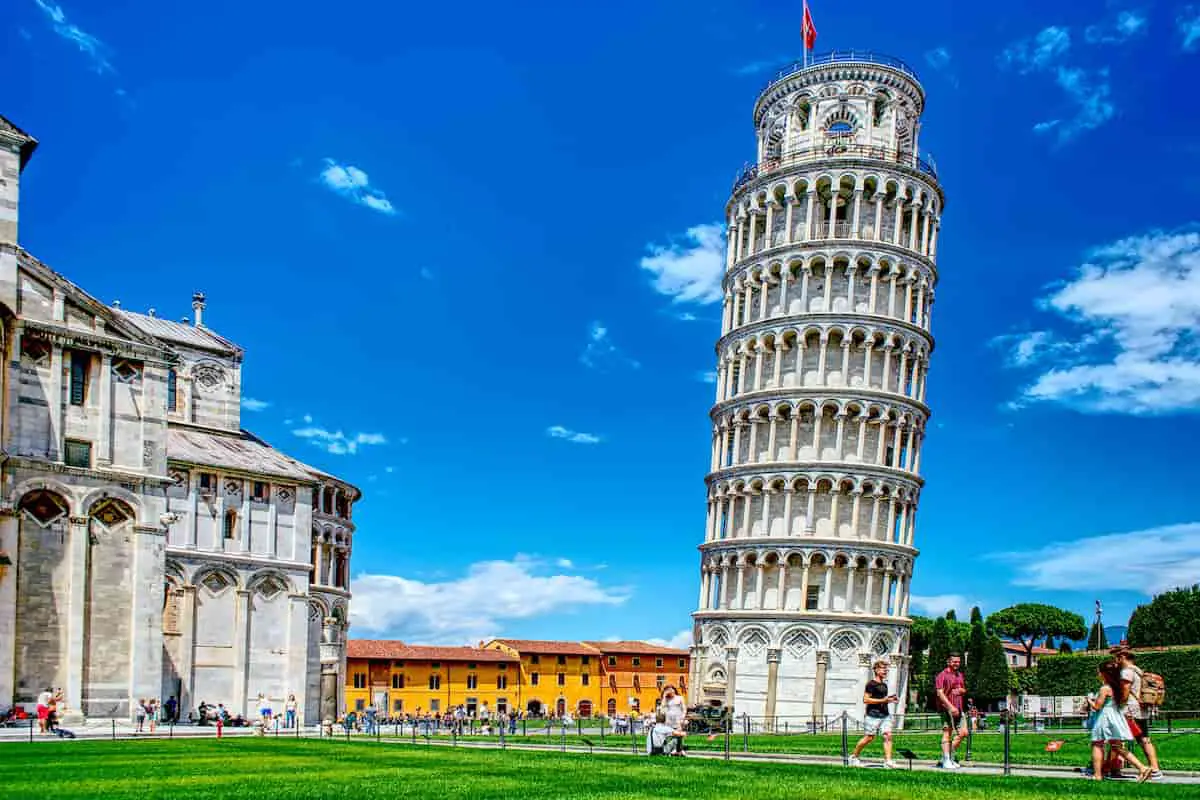If you’re planning a visit and want to know what to do in Pisa, Italy, continue reading and discover the invaluable information and tips we’ve prepared just for you!
Pisa, a charming city nestled in Italy’s picturesque region of Tuscany, draws tourists from around the globe, thanks to its rich history and architectural wonders.
Although, the iconic Leaning Tower of Pisa, situated in the breathtaking Piazza dei Miracoli, is the most famous and unmissable attraction.
The city also houses numerous other historical treasures like the majestic Pisa Cathedral, the intriguing Pisa Baptistry, and the charming Church of San Stefano.
Pisa Cathedral
Experience the beauty of Pisa Cathedral, with its stunning interior dating back to the 11th century. Indeed, it’s one of Pisa’s must-see attractions!
When the Pisans began constructing the Cathedral, they aimed to create a masterpiece that would forever symbolize their city’s grandeur.
Today, nearly a thousand years later, this magnificent structure ranks second as the city’s most popular tourist spot, just behind the famous Leaning Tower.
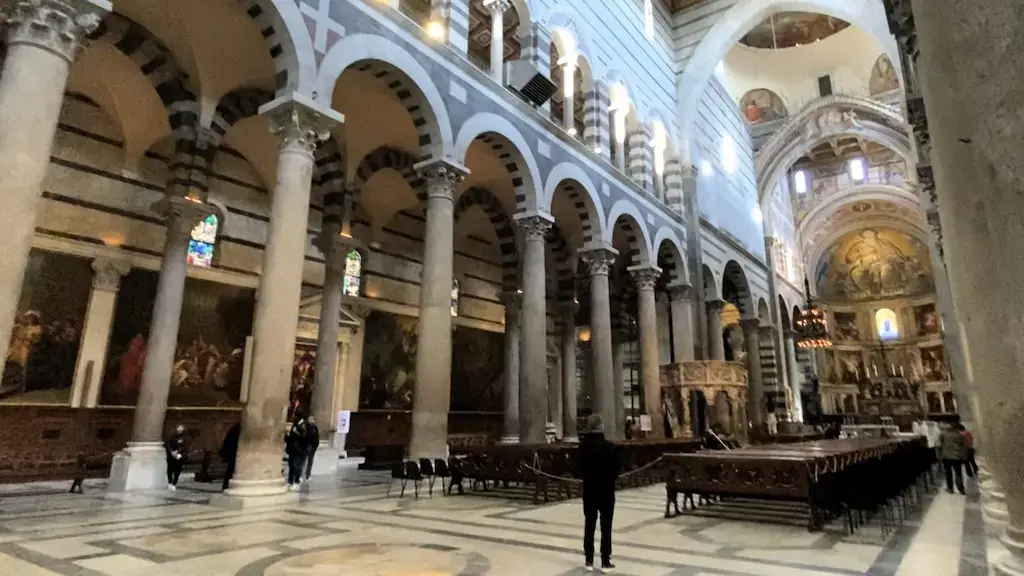
The construction of Pisa Cathedral began in 1063-1064 under the architect Buscheto. The Pisans used the tithe earned from conquering Palermo to fund its construction.
The building bears tangible signs of this wealth, like the Muslim griffin that adorns the roof on the side facing the Tower, and the colossal Corinthian granite columns between the nave and the apse.
Indeed, Pisa Cathedral exemplifies Pisan-Romanesque architecture, with its consecration taking place in 1118.
The gray and white marble facade displays polychromatic mosaics, six blind arches, and four overlapping orders of small loggias.
Sculptors from Giambologna’s workshop created the three bronze portals on the facade.
The elliptical dome, covering the entire complex, features sharp-profiled arches and an Arabic influence in its decoration.
Undoubtedly, Pisa Cathedral is an architectural and artistic treasure appreciated and admired by all. It represents a living example of the Pisans’ grandeur and skill during the medieval period.
The Interior of Pisa Cathedral
The Cathedral boasts an interior divided into five naves, with lighting enhanced by the use of black and white marble.
The monumental mosaic of Christ in Majesty occupies the apse, behind the altar, accompanied by the Virgin Mary and Saint John the Evangelist.
Completed in 1302, Saint John’s face miraculously escaped the 1595 fire.The remarkable pulpit by Giovanni Pisano, carved between 1302 and 1310, enriches the Cathedral.
Densely decorated curved panels with relief sculptures comprise the pulpit, supported by columns.
Two of these rest on lions, while three others take the form of caryatids. The central nave houses Galileo’s Lamp, an object that inspired the scientist to formulate the laws on the isochronism of the pendulum.
Pisa Baptistry
The Pisa Baptistry, a masterpiece of Romanesque architecture, with its impressive dome and elaborate marble decorations.
Although it might seem overshadowed by the Tower and the Cathedral, the Baptistry of Saint John the Baptist is also an extraordinary monument and the largest of its kind in Italy, boasting a circumference of 107.24 meters and a height of 54.86 meters.
Its walls can be up to 2 meters thick.
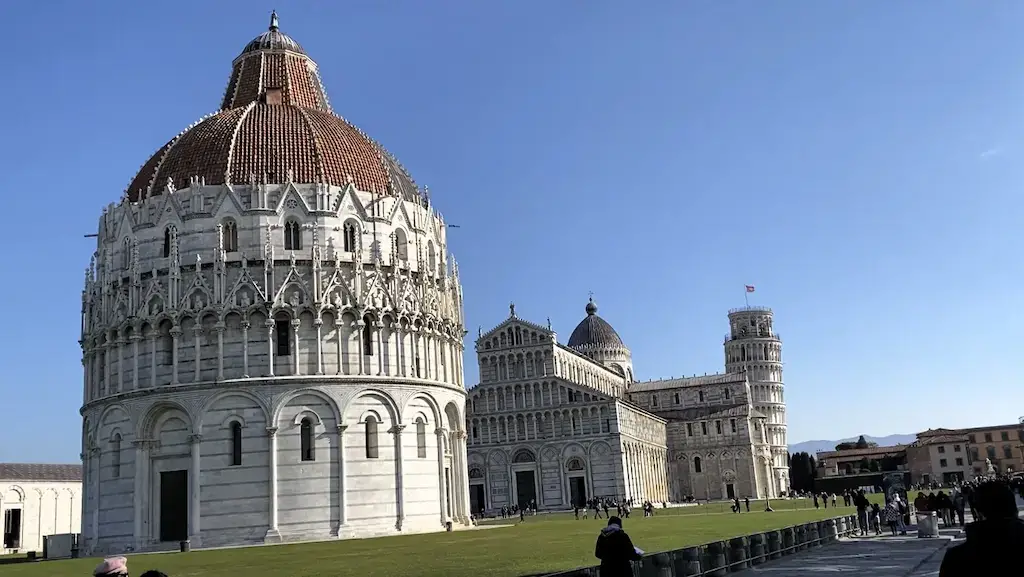
The construction of this Romanesque monument, situated in front of the Cathedral’s west facade in Piazza dei Miracoli, began in 1152 under the master Diotisalvi.
However, the Baptistry remained unfinished until the end of the 14th century.
Take a Break: Hotels in Pisa!
After exploring the wonders of Pisa, you’ll undoubtedly want a comfortable place to rest and recharge. We’ve handpicked five hotels that stand out for their quality, location, and amenities.
Check out our suggestions and choose the perfect option for your stay in Pisa:
- Hotel Relais Dell’Orologio: Enjoy luxury and charm just steps away from the Tower of Pisa in this elegant hotel.
- Hotel Di Stefano: Choose this mid-range accommodation and savor the stunning view from the rooftop terrace.
- Hotel Alessandro Della Spina: Opt for comfort and modern amenities at this budget-friendly hotel, perfect for those looking for a more economical choice.
- Hostel Pisa: For travelers on a tight budget, this affordable and laid-back hostel is undeniably an excellent choice.
- Pisa Central Apartments Feel at home in one of these spacious vacation rentals, ideal for longer stays or larger groups.
National Museum – What to Do in Pisa?
The National Museum of Pisa is, without a doubt, a must-visit destination for art and history enthusiasts, where you can explore Tuscan art from the 12th to 18th centuries, including works by renowned artists like Simone Martini and Andrea Pisano.
The National Museum of San Matteo, located inside the medieval Convent of St. Matthew and overlooking the Arno River, is the most significant museum of painting and sculpture in Pisa.
Its collection began with the donation made by Monsignor Zucchetti to Opera del Duomo in 1796 and continued to grow in the 19th century with the addition of many religious-themed masterpieces.
The exhibition features works by leading Pisan and Tuscan artists from the 12th to the 17th centuries, and includes an archaeological and ceramic section.
Among the main art pieces of the 38 rooms, stand out an extraordinary series of painted crosses, such as the Crucifix by Giunta Pisano, from the first half of the 13th century, and the Cross of Fucecchio, by Berlinghiero Berlinghieri, from the same period.
Also worth noting is the stunning Madonna of the Milk, a 14th-century statue by Nino Pisano, and a polyptych by Simone Martini.
If you whant more what to do in Pisa, is a good place to visit!
Leaning Tower of Pisa
Ready for your next travel adventure?
Make sure to snap that classic picture pushing the Leaning Tower of Pisa, but not before you appreciate the beauty of its medieval architecture and the story behind this iconic tilted tower.
The Leaning Tower of Pisa is a world-renowned monument, a 56-meter tall bell tower famous for its unintentional tilt, due to the soft soil beneath the city of Pisa.
Currently, it leans 3.99 meters off vertical and has only recently been stabilized at this angle after preservation work initiated in 1990.
The stabilization process involved the use of steel cables and cement injections into the foundation to curb the tower’s gradual tilt.
Construction of the Leaning Tower of Pisa began in 1173. By 1185, the tower had started to lean, leading to a halt in construction. However, work resumed shortly after and the bell tower was eventually completed in 1360.
The tower’s tilt must have been evident early on as by 1198, there was already a bell ringer in the Cathedral.
Giovanni De Simone took over the task of completing the construction in 1260, and altered the building’s axis to prevent an even greater lean.
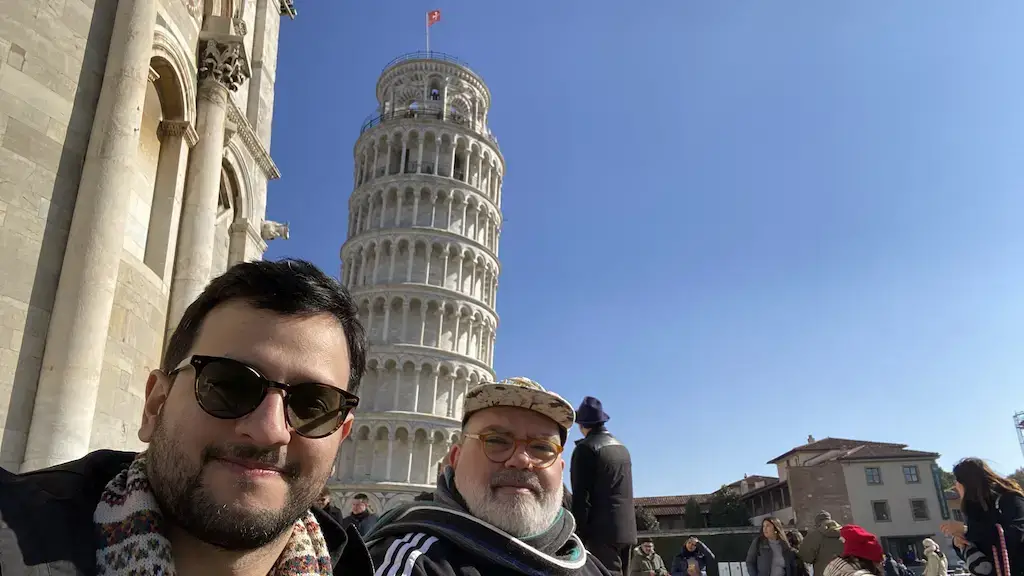
This modification resulted in an extraordinary work of beauty that harmonizes perfectly with the Cathedral, reflecting the pattern of blind arches on the first level.
Undeniably, the Leaning Tower of Pisa stands out as one of the finest examples of Pisan Romanesque architecture.
It features six orders of small, slender, superimposed arches that lend the structure an exceptional lightness.
While tradition attributes the design of the Tower of Pisa to Bonanno Pisano, the true authorship of the tower remains unknown.
Monumental Cemetery of Pisa
Embarking on your Pisa journey, don’t overlook the Monumental Cemetery, the last masterpiece in chronological order in the Piazza dei Miracoli.
Despite seeming to take a backseat to the Tower and the Cathedral, it holds a significant place in the history of Pisa.
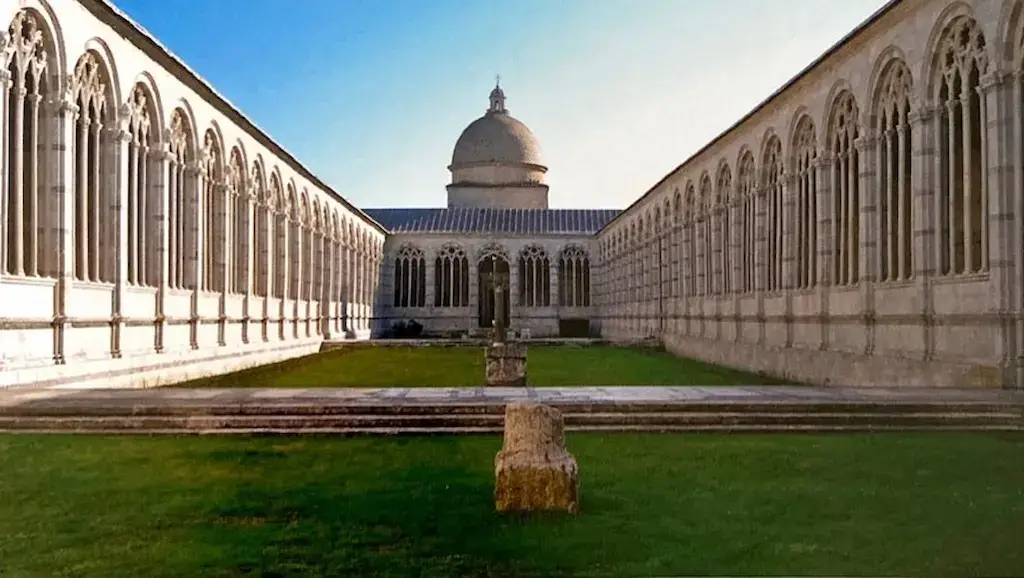
Initiated in 1277 by Giovanni di Simone, the cemetery was probably conceived to gather the many tombs that multiplied between the Cathedral and the Tower.
It’s a large rectangular structure with a high white marble wall decorated with 43 blind arches and two outward-facing entrances.
Builders worked on the cemetery, with some interruptions, until 1464 when they finished the internal floral Gothic arches that give the structure the appearance of a cloister.
The inner lawn housed many sarcophagi, about thirty of which date back to the Roman era, but by the 19th century, they were no longer on site.
Over the decades, renowned artists such as Andrea Bonaiuti, Taddeo Gaddi, and Benozzo Gozzoli adorned the internal walls with frescoes.
Unfortunately, in 1944, bombs severely damaged these paintings. Currently, restoration continues to repair the damage.
Museo dell’Opera del Duomo of Pisa
An exciting stop on your Pisa itinerary should be the Museo dell’Opera del Duomo, a treasure trove of sacred art where you can appreciate sculptures and frescoes from the Cathedral, Baptistery, and the Leaning Tower of Pisa while learning about their history.
The Museo dell’Opera del Duomo, situated in Piazza dei Miracoli, houses numerous statues, reliquaries, fragments, and other objects that tell the story of the square’s monuments.

The museum building, constructed in the 13th century, served as the Chapter House of the Cathedral.
Opened in 1986, the museum features twenty-three rooms. From the cloister-style courtyard, visitors can enjoy an exceptional view of the Leaning Tower of Pisa.
Displayed sculptures include very ancient pieces dating back to the construction years of the Cathedral, Tower, Baptistery, and Monumental Cemetery.
For instance, the second room houses the original splendid Door of St. Ranieri, cast in bronze by Bonanno Pisano in the 12th century and now replaced in the Cathedral by a replica.
The third room holds more Cathedral pieces like the large Islamic bronze griffin, brought to Pisa as war loot, which was originally on the Cathedral roof facing the Tower and has been replaced by a copy today.
The fifth and sixth rooms feature many original Baptistery statues, leading to the seventh room which houses masterpieces of Giovanni Pisano’s extraordinary production.
Of great importance, for example, are the Madonna of the Conversation from the mid-13th century, and the three pieces of St. John the Baptist, Virgin Mary with the Child, and St. John the Evangelist (1306), which once adorned the external lunette of the Baptistery entrance.
Artworks, Relics and Other Rooms at the Museo dell’Opera del Duomo of Pisa
Another remarkable 14th-century artist, Tino di Camaino, has his works displayed in the eighth room, known as the Henry VII Room.
This room contains the sculptural elements of the tomb of the Holy Roman Emperor (who died in 1313). Completed in 1315, the funerary monument originally stood in the Cathedral’s apse and was later removed and dismantled for political reasons.
The eleventh room houses an extraordinary collection of antique objects and reliquaries, including a delicate Ivory Madonna, carved from an elephant’s tooth by Giovanni Pisano in 1298.
Continuing the museum tour, the sixteenth room deserves time for its ancient illuminated choir books from the Cathedral that survived the 1595 fire. In the twenty-first room, visitors can appreciate reproductions of the Monumental Cemetery frescoes as they were before the 1944 bombing.
In the courtyard, more statues from the school of Nicola and Giovanni Pisano, which used to be outside the Baptistery, are on display. Be sure to explore these hidden gems on your visit to Pisa.
Piazza dei Cavalieri – What to Do in Pisa?
The Piazza dei Cavalieri is indeed one of Pisa’s most famous and beautiful squares, with its impressive statue of Cosimo I, the elegant Renaissance palaces, and the fascinating history of the Order of the Knights of St. Stephen.

Just as Piazza dei Miracoli is Pisa’s religious center, Piazza dei Cavalieri has always been the center of temporal power since Roman times, when it was the site of the city’s forum.
During the glorious Maritime Republic, the Captain of the People, the most important figure governing the city, had his residence here.
With the advent of Florentine rule, the Medicis wanted to transform this square, dedicating it to the Order of the Knights of St. Stephen.
They invited Vasari to design it and he turned the old Palazzo del Popolo and other nearby structures into the Palazzo dei Cavalieri, the current headquarters of the Scuola Normale di Pisa, the city’s renowned university.
The facade of the building features graffito decoration, and niches that house portraits of the Tuscan grand dukes.
In the square, there is also the Palazzo dell’Orologio, from 1357, which incorporates the old Tower of Muda, or of Hunger, where Count Ugolino, mentioned by Dante in Canto XXXII of Inferno, died.
Galleys’ Arsenal
Immerse yourself in Pisa’s rich maritime history at the Galleys’ Arsenal – an ancient naval shipyard dating back to the 13th century.
Originally built for galley production – these oar-driven vessels were primarily used for warfare and maritime trade.
Pisa’s Galleys’ Arsenal was among the most significant naval shipyards in Medieval Europe and played an essential role in the history of the Republic of Pisa.
Although galley production ceased in the 17th century, the Arsenal continued to thrive, transitioning to other activities such as boat construction, and producing ropes and nets.
Today, the site is home to the National Transport Museum, boasting a collection of historic ships, carriages, and other vehicles.
The Galleys’ Arsenal stands as a testament to Pisa’s historical significance as a maritime and commercial hub in the Mediterranean.
Ponte alla Fortezza
Connect with the past as you cross the historic Ponte alla Fortezza in Pisa, Italy.
Spanning the Arno River, this bridge links the city’s historic center with the Sant’Antonio neighborhood. Constructed in 1949, it replaced an old railway bridge that was destroyed during World War II.
The name “alla Fortezza” references the Fortezza Nuova, a 16th-century fortress built to protect the city.
The bridge has four traffic lanes and two pedestrian walkways, offering stunning views of the river and nearby historical buildings.
Ponte alla Fortezza serves as one of the main access routes to Pisa’s airport and a crucial entry and exit point for the city.
Additionally, the bridge often hosts local events and celebrations, including New Year’s festivities.
Church of St. Martin
The Church of St. Martin is a Roman Catholic church located in the eponymous square in the city of Pisa, Italy.
Built in the Romanesque-Pisan style in the 11th century, the church is dedicated to St. Martin of Tours and features a simple yet elegant facade.
The main portal features animal sculptures and reliefs depicting biblical scenes, while the figure of Christ surrounded by angels and saints adorns the tympanum.
Inside, the church comprises three naves, with marble columns and capitals decorated with plant and animal motifs.
Highlights of the church include Andrea della Robbia’s painting “Madonna with Child and St. John the Baptist,” the wooden image of the “Dead Christ,” and a series of 17th-century frescoes.
The Church of St. Martin is a significant example of Pisa’s religious architecture and a site of great historical and cultural interest.
Exploring Galileo Galilei’s Life
Unveil the life and works of the famous Italian scientist Galileo Galilei at the Galileo Museum in Pisa.
Dive into the history of science as you explore its collection of ancient scientific instruments. The world-renowned Pisan, Galileo Galilei, was a versatile genius whose inventions, such as the telescope, and support of Copernican theories marked the beginning of modern science.
Galileo formulated his critical theories on the isochronism of the pendulum and the laws of falling bodies in Pisa, inspired by observing the swinging lamp in the central nave of the Cathedral and the dropping of objects from the Leaning Tower of Pisa.
Beyond the Main Attractions
Beyond its main attractions, Pisa offers charming streets, delectable restaurants like La Taverna di Pulcinella.
Also, numerous museums, and gardens like the Botanical Garden and the Museo dell’Opera del Duomo.
Enjoy a day trip to Florence, or relax on the Mediterranean Sea’s beaches just a short drive away. In conclusion, Pisa is a culturally rich and exciting destination that offers something
for everyone, from history buffs to foodies and nature lovers.
Is It Worth Visiting Pisa?
Pisa is an Italian commune located in the Tuscany region, globally renowned for its iconic attraction, the Leaning Tower of Pisa, situated in the Square of Miracles.
Alongside the Tower, the Square houses other touristic spots such as the Pisa Cathedral, Pisa Baptistery, and Camposanto Monumentale, making a visit worthwhile.
With time on your side, you will find the Piazza del Duomo, a Gothic-style masterpiece and part of humanity’s heritage.
Other attractions include the Knights’ Square, University of Pisa, Botanical Garden, and the Palazzo dell’Orologio.
Arrival by train is straightforward at Pisa Centrale station. Pisa also offers tours to San Gimignano and Florence, as well as travel insurance for those touring Europe.
A city steeped in history and art, having been a significant center in the Middle Ages, we recommend a visit to Taverna di Pulcinella, Scuola Normale Superiore, and Arno River.

